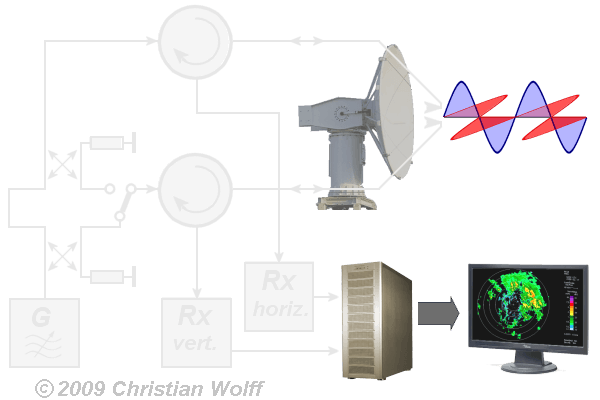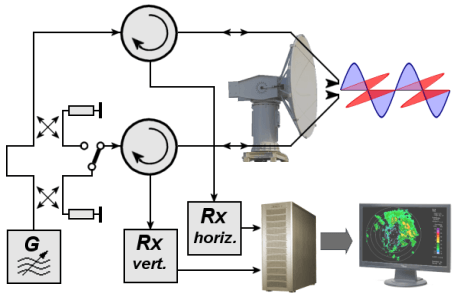Polarimetric Radar
At this example of a polarimetric radar the transmitting energy is divided by a -3dB-coupler into two parts of the complete power. These two parts are sent by a dual polarization feed horn with a different polarization simultaneously.

Figure 1: Simplified Block Diagram of a Polarimetric Radar

Figure 1: Simplified Block Diagram of a Polarimetric Radar

Figure 1: Simplified Block Diagram of a Polarimetric Radar
By a switch this radar can transmit in a single polarization plane for measurements of the reflectivity only (just with this one then with the double power, however). But in this case however the radar also receive in the two polarization levels. Both signals are evaluated in the signal processor.
This is very expedient since the orientation of the electric field always changes itself at a reflection.
Transmitter
The radar transmitter produces the short duration high-power rf pulses of energy.
Power divider (-3dB Hybrid #1)
This power divider divides the transmitters power into two equal parts. One part of power will be radiated into space by the vertical polarized feedhorn, the other one by the horizontal polarized feedhorn.
Power divider (-3dB Hybrid #2)
If single polarisation is switched, then the divided parts of energy are added again into this powerdivider.
Switch dual/single polarisation
The part of transmitters power for vertically polarization would be conduct either to the feedhorn for vertically radiation (then the radar ist dual polarized), or back to the main horizontally feedhorn (then the radar ist single polarized).
Detour line for the phase coincidence
The detour line provide phase coincidence of the both parts of energy.
Parabolic reflector
The directivity of the feedhorns is added to that of the parabolic reflector. The resulting pattern is a very narrow and concentrated beam with dual polarisation.
Dual Feedhorn
A dual feedhorn is used to feed the transmitters energy into the parabolic reflector with the necessary polarizations.
Ferrite circulator (Duplexer)
The duplexer alternately switches the antenna between the transmitter and receiver so that only one antenna need be used. This switching is necessary because the high-power pulses of the transmitter would destroy the receiver if energy were allowed to enter the receiver.
Receiver
The receivers amlify and demodulate the receives RF-signals. The receiver provides videosignals on the output.
Signal Processor
The signal processor is that part of the system which separates weather information from clutter on the basis of Doppler content and amplitude characteristics.
CAPPI - Scope
The indicator should present to the observer a continuous, easily understandable, graphic picture of weather information.
